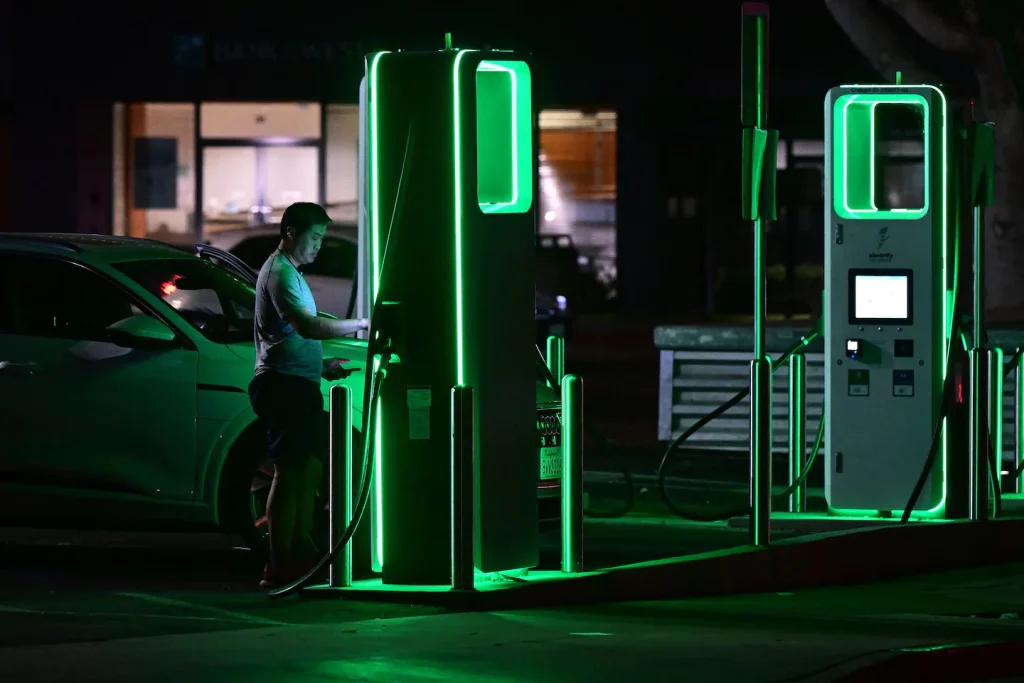
According to new study From researchers at Stanford University, if sales of electric cars grow rapidly over the next decade — and most drivers continue to charge their electric vehicles at home — car charging could strain the power grid in the western United States, increasing peak net demand by 25 percent. percent. This could be a problem as the West is striving for it Leave the lights on In the midst of heat waves and high demand for electricity.
The first thing to know about electric vehicle charging is that it is not the same as filling a car with gasoline. Charging an electric car takes time — While the fastest chargers can charge an EV battery to 80 percent in 20 to 30 minutes, most chargers are even slower, taking between 2 and 22 hours to reach a full charge. This means it 80 percent Charging of electric vehicles occurs in the owner’s home, overnight – when the driver does not need the car and can leave plenty of time to charge it.
But this charging pattern is at odds with how electricity is increasingly being generated. The greatest demand for electricity occurs in the evening, between 5 and 9 pm, people come home from work, turn on the lights, watch TV, and do other energy-intensive activities. Meanwhile, the solar panels produce their energy in the middle of the day. So, the highest demand for electricity occurs only when solar energy starts close for this day.
In the Stanford study, researchers model the charging behavior of residents in 11 western states, then analyze how this behavior will affect an electricity grid that is increasingly turning to renewables and other clean energy sources.
“Once 30 or 40 percent of cars become electric vehicles, they’re going to start to have a huge impact on what we do with the grid,” said Ram Rajagopal, a professor of civil and environmental engineering at Stanford University and one of the study’s authors. Even if drivers wait until after rush hours and set their cars to charge at 11pm or later, they will use electricity at the exact time when renewable energy isn’t readily available. This could lead to increased carbon emissions and the need for more batteries and storage in the power grid.
One solution, say the researchers, is if more electric vehicle owners switch to charging during the day, charging their cars at work or on public chargers. If electric vehicles are charged in the late morning and afternoon, when the grid has excess solar capacity that is not being used, there will be less stress on the electricity system and less storage will be needed. According to the study, under a scenario where 50 percent of cars are electric, switching from home to a mix of charging at home and at work could roughly halve the amount of storage needed on the grid. Adding workplaces and public chargers has the added benefit of helping too tenants Or those without homes have access to electric vehicles.
Siobhan Powell, a postdoctoral researcher at ETH Zürich in Switzerland and lead author of the study, says the time to plan for an expansion of public space fees and work is now. “We don’t say, ‘Don’t have more home charging,’ or ‘limit home charging,'” she said. “We don’t want to be discouraged. Which Charging a fee because this is really important for adoption. But there is a lot of money being spent on shipping, and we can make it as comfortable at work or in public as it is at home.”
The authors also recommend shifting electricity price structures to better stimulate charging in the middle of the day. Currently, some utilities are offering very low electricity rates for consumers to charge their cars overnight. PG&E, for example, a California service, Offers electric vehicle owners Electricity for 25 cents overnight between midnight and 7 a.m. and 36 cents between 7 a.m. and 2 p.m. Ideally, Rajagopal and Powell say, the cheapest rates should be in the middle of the day to incentivize shipping at sunset.
Current electric vehicle owners don’t need to worry about their charging patterns, said Jill Tal, director of the Center for Electric Vehicle Research at the University of California, Davis, who was not involved in the research. “We don’t need to hit the brakes when using electric cars,” he said. He says that as more clean energy and storage are added to the grid, many of these issues will be resolved.
But he agrees that one of the advantages of electric vehicles is the flexibility when they can charge. Switching to daily charging will come in handy, whether it’s charging at home during the day (for those who work from home) or providing chargers at the workplace.
He said policy makers need to “place chargers where cars are during the day.”

“Web maven. Infuriatingly humble beer geek. Bacon fanatic. Typical creator. Music expert.”





More Stories
Bank of Japan decision, China PMI, Samsung earnings
Dow Jones Futures: Microsoft, MetaEngs Outperform; Robinhood Dives, Cryptocurrency Plays Slip
Strategist explains why investors should buy Mag 7 ‘now’